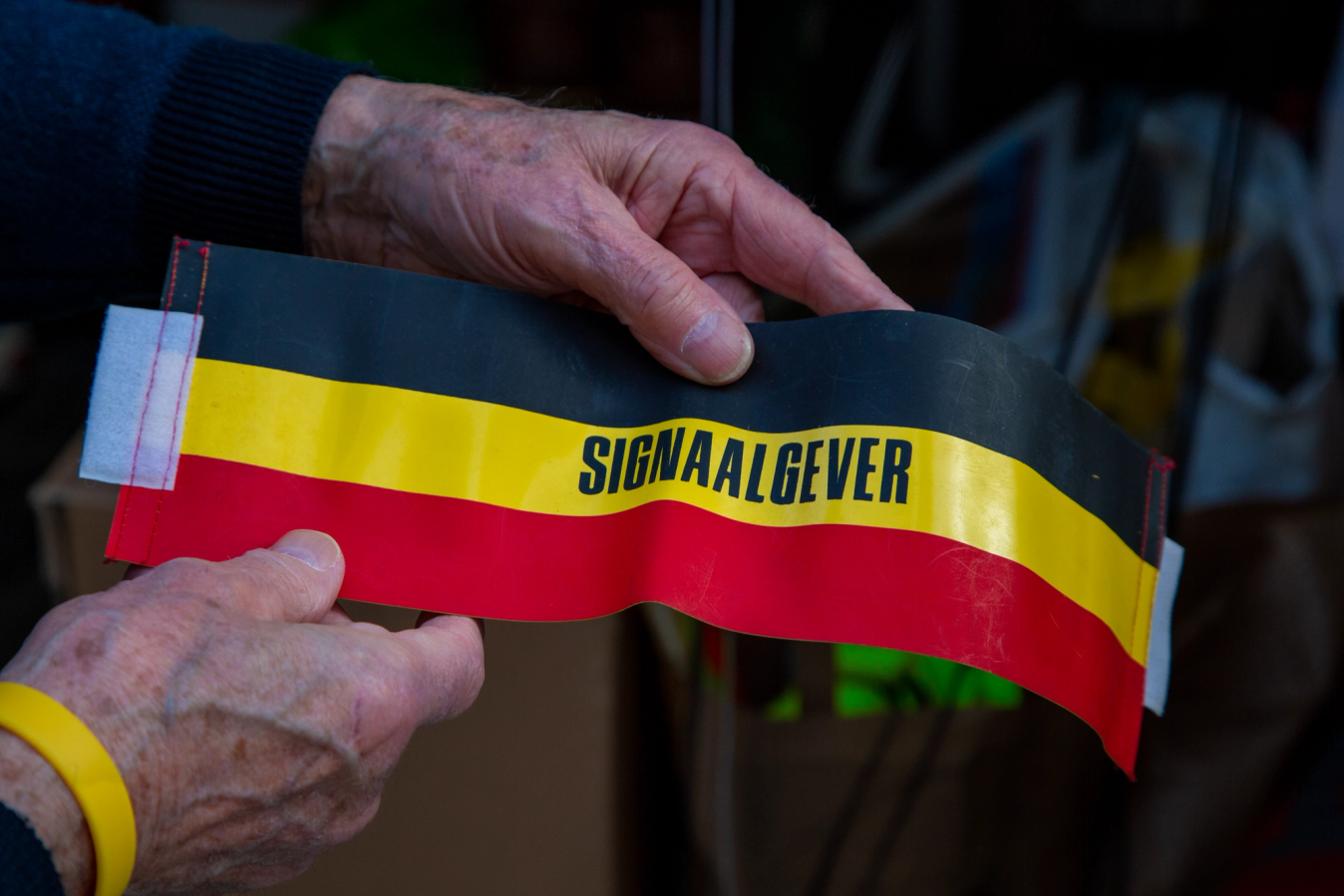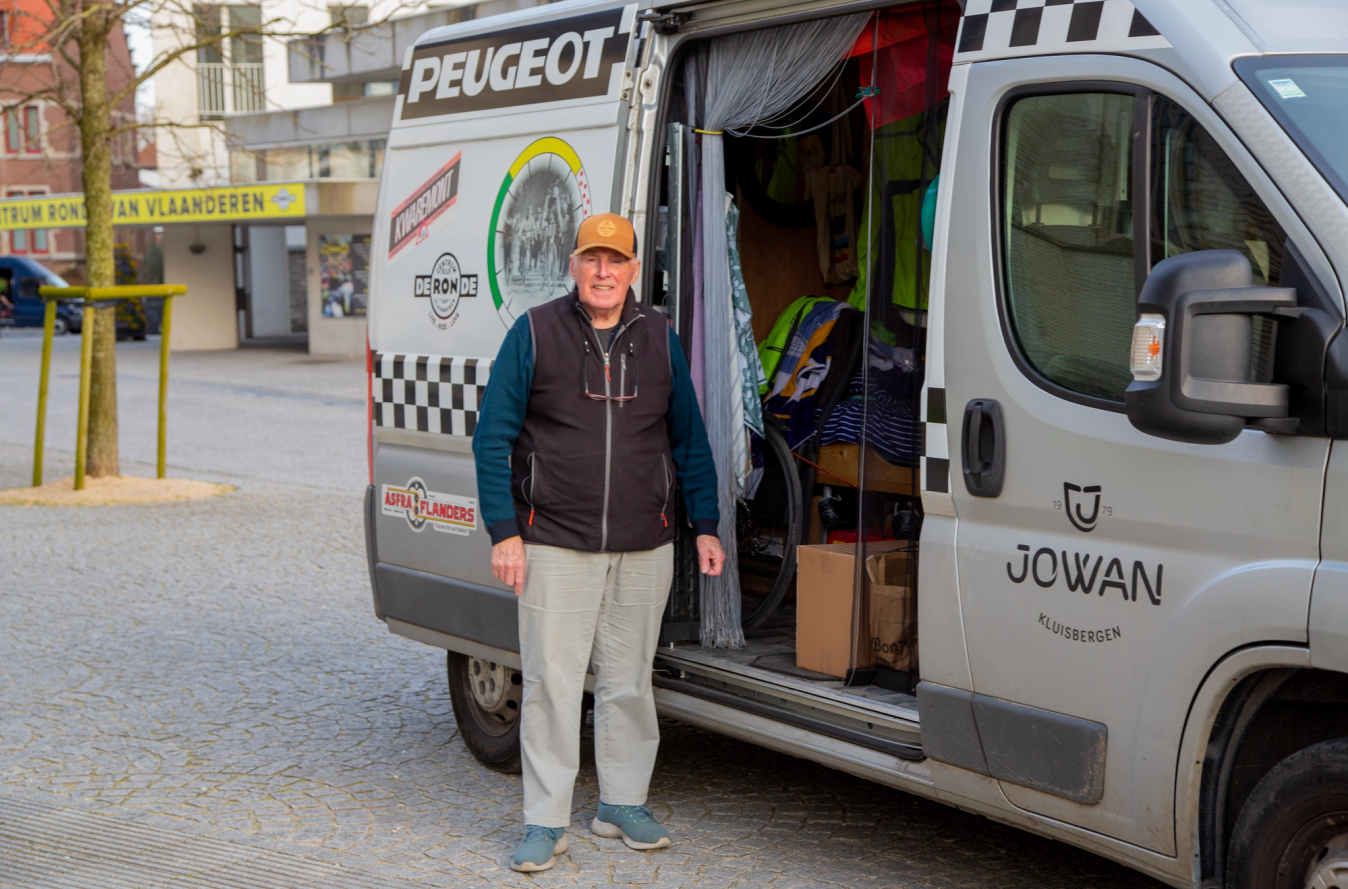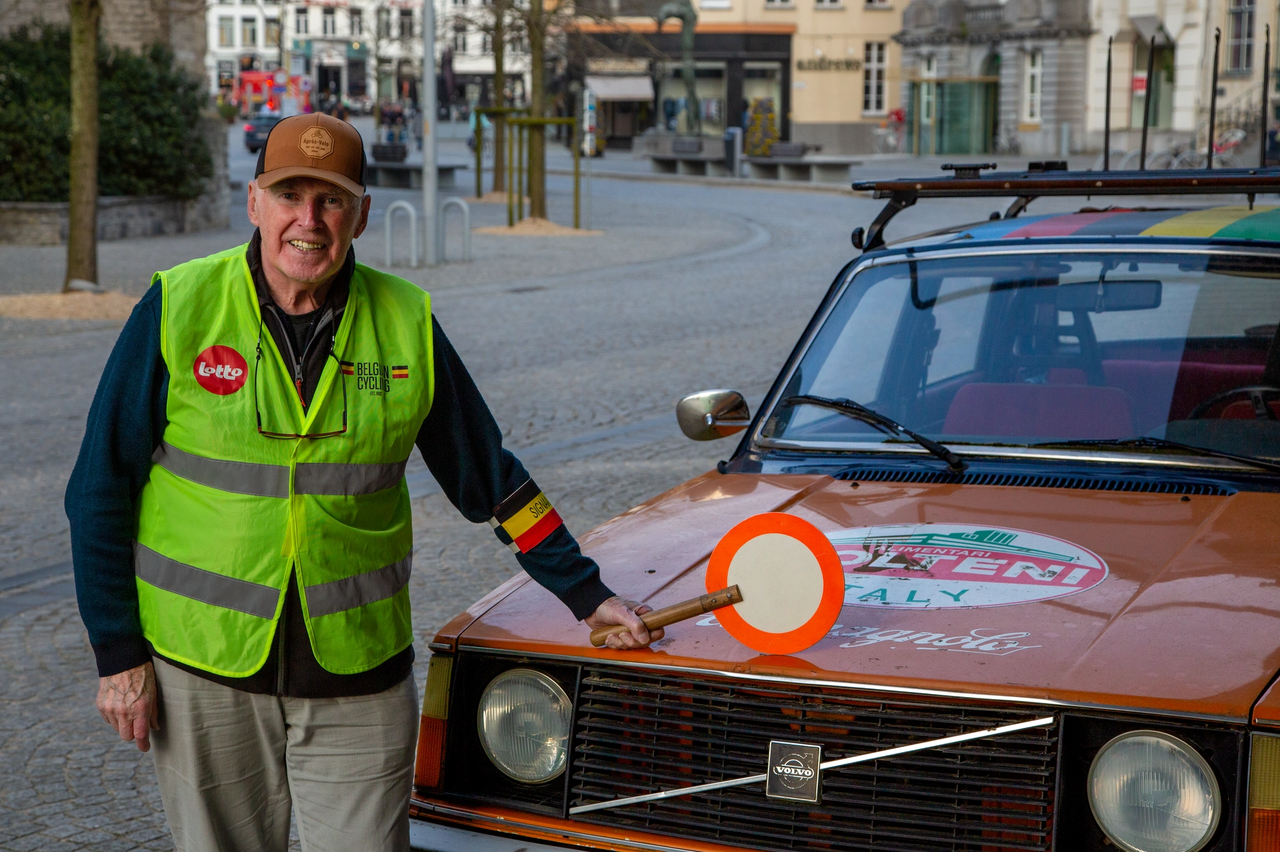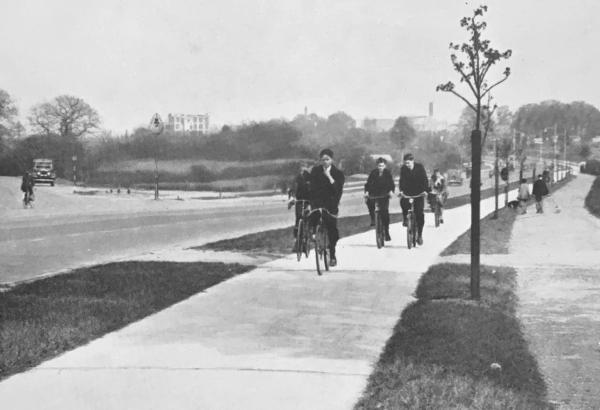66 years marshalling at the Tour of Flanders: Meet Lucien De Schepper
Since 1958, Lucien De Schepper has been a signalman at the Tour of Flanders, and his passion for cycling is still unwavering
James Howell-Jones
Junior Writer
© GCN
Lucien de Schepper in his signaller vest and armband
For the past 66 years, Lucien De Schepper has been a marshall at the Tour of Flanders. The 84-year-old from Oudenaarde, Belgium, first took his place as a ‘signalman’ in 1958, at the age of 18, and he has done so at every edition of the race since then.
Over the years, he has seen the Tour of Flanders go from having about a thousand spectators, to, by his count, about a million. He has seen the Flemish countryside change completely. And he has seen all the greats, from Eddy Merckx to Wout van Aert, tear past as he holds back spectators and traffic.
We met Lucien at the Tour of Flanders Centre in Oudenaarde, Belgium. The centre is a museum for the Tour of Flanders where Lucien volunteers, offering guided tours of the local cobbled climbs, and sharing his unique insight into the race and the region with visitors. He might be 84 years old, but he is still fighting fit, full of enthusiasm, and as madly in love with the sport of cycling as he ever was.
Falling in love with cycling
When we arrive to meet Lucien, we find him sitting with his wife Claudine watching the final moments of stage 2 of the Volta a Catalunya. Tadej Pogačar has left the rest of the field well behind, and the results of the day are on screen. As we walk over, he gestures to the screen mounted high on the wall and says, simply, “Pogačar. One minute twenty-three — incredible.”
Lucien is a devotee to the sport of cycling. It absorbs his mind and it fills his days. The morning after our visit, he is due to take a group of visitors around the Roubaix Velodrome, showing them the iconic finish of the race. This, by all accounts, is a typical Wednesday for Lucien. If you ask him why he spends his days paying homage to the sport’s most iconic climbs, finish lines and cobbled sectors, he gives a simple response:
“When you love cycling, that’s how it is.”
It’s a love affair that began when he was just seven years old, when the Tour de France came to Belgium for the Grand Depart for the very first time.
“1947 was the first time the Tour de France came to Belgium. The newspaper Het Volk, now Het Nieuwsblad, made a pull-out that had all the results, and all the details of the stages. And you had to look for a little mouse — it was bizarre, but funny.
“It was quite expensive — a newspaper cost one Belgian Franc and this thing cost 85 cents — but everyone bought this little newspaper.
“All the kids from seven to 15 would be out selling them in the street. They’d have their yellow hat, their little yellow cart. In there, they’d put 50 of these newspapers and every day you had to sell all of them.
“The Tour was won that year by Jean Robic, the little Frenchman. He won at the very last moment in Paris,” remembers Lucien.
Lucien was swept up in Belgium’s cycling craze, but it wasn’t until he got his first taste of the Tour of Flanders that his passion for the sport really crystalised.
“Really, I got into cycling when I was 12. It was 1952 and that was the year of the first Tour of Flanders for cycle-tourists.
“My brother and father rode it, and myself and my mother rode to Gent to see the start.”
Once he was old enough, Lucien took on the cycle-tourists’ Tour of Flanders event himself. He was a complete convert to cycle-tourism, even forming his own club.
“The club was called WTC (weilertoeristenclub) Rap en Glad — that means fast and well,” he explains. “We did it all. We did Belgium to Rome, Belgium to Lourdes, Belgium to the Cauberg, Belgium to Castel Madama… we went everywhere: 10-day trips, 12-day trips, 14-day trips. Rome was 18 days, all on the bike. Incredible days!
“One time I rode from Oudenaarde to Barcelona for the World Championships in Barcelona. Felice Gimondi won that day, second was Freddy Maertens, then Luis Ocaña and Eddy Merckx,” recalls Lucien — every memory, it seems, includes the results of the racing that day.
Becoming a signalman
Lucien first tried his hand at marshalling not at a bike race, but at the very first World Fair: the Expo 58, held in Brussels, 1958, during which Lucien was 18 years old and a student.
“The Gendarmerie [the domestic security branch of the military], they asked for young people to lend a hand, to tell people where to go, block the road and so on. On every crossroads there was one gendarme, plus one signaller. Everyone had a vest, an armband, and a banner. Everyone had to stop for us.”

© GCN
Lucien’s signaller armband, bearing the colours of the Belgian flag
It was during his time at the World Expo that Lucien found that he was a natural-born signalman.
“1958 was the moment I realised I could become a signalman, because of the Expo. I was good at it, and they liked me. You have to keep your eyes open the whole time. The gendarmes told me ‘you are the guy we’re looking for’, and that always stuck in my head.”
In the 1950s and 1960s, bike racing in Belgium was booming. As the prestige of the races grew and grew, it was considered an honour, Lucien said, to be a signalman.
“Without signallers, there’s no racing,” he explains. “Belgium is the only country where we work with signalmen. In France, it’s gendarmes. In Holland, it’s security officers, in England, it’s volunteers.
“Signallers are very important. You can’t miss one crossroads site, whether it’s a big one or a small one. It’s a long route, and you have to have someone at every crossroads.”
Lucien tells us that for the Tour of Flanders, there are around two thousand signallers each year ("Antwerp to Oudenaarde, 2,121 signallers. From Bruges to Oudenaarde, 1,693 signallers"). With each one receiving a modest sum of between €15 and €41.50 a day, this is a role that people take up for no other reason than a love of the sport.
“You have to do it as a passion, you have to love cycling, love racing, otherwise you wouldn’t do it,” he explains.
Watching the race change over the years
Since Lucien first donned his signalman’s vest in 1958, more or less everything about de Ronde has changed. The roads have been resurfaced, and in many instances, re-cobbled. The route has changed almost beyond recognition, and Flanders itself has gone from a quiet rural region to a thriving tourist destination. Ask Lucien what’s different about the racing today, though, and the first thing that comes to his mind is the number of fans on the roadside.
“The spectators are crazy. The first Ronde, maybe there were a thousand people. Now there are a million. Everything is getting bigger and bigger and bigger every year — and better and better and better! You see the finish there, it’s all already being set up, and the tents on the Oude Kwaremont for the VIPs are all up already.”
Lucien delights in seeing his local races grow in popularity each year. He wants to share the joy of cycling with as many people as possible — why else would he spend his days sharing the story of this race with visitors?
Seeing his amazement at Pogačar’s victory, it is clear Lucien is not an old fogey with a ‘back in my day’ mindset. He sees the brilliance in modern cycling, and even notices a few parallels between the greats from the past, and the greatest riders of the modern era.
“Apart from my cousin [two-time podium finisher André Dierickx], my favourite rider was Rik Van Looy,” said Lucien. “He’s 90 years old this year. I liked his character. He rode like Van Aert, always on the front, riding hard.”
Even so, Lucien thinks Van Aert is missing the pacing skills that helped Rik Van Looy win the Ronde in 1959 and 1962.
“He’d save strength for the last 20km, and Van Aert does not do that. He has to understand that the last 20km you have to have something in reserve.
“His directors need to explain to him on the radio: ‘softly, softly does it’, but that’s his character. He likes to fight, to show himself.”
84 years young
Lucien shows no signs of slowing down. Sitting with us in the late afternoon, he is bright-eyed and extremely talkative. We ask him whether his age is making his role as a signaller more difficult.
“I’m 84, but I’m doing quite well. When the head is good, the legs are good, and the heart is good, it’s all good. But I still have the energy.”
“More than me”, his wife Claudine interjects, with a good-humoured look of exhaustion.
“You have to love it,” Lucien continues. “I still ride my bike, every weekend, 30 or 40 kilometres. But energy makes it all happen.”
As well as riding his bike regularly, Lucien still marshalls at around 20 to 25 races a year — a dramatic reduction from the 60 to 65 he used to take on, but still enough to fill most weekends of the season.
Ultimately, it all comes back to his love of cycling.
“Football is good, but with cycling you see the world,” he explains. “You see the countries, the landscapes, the sea, the mountains, nature. It’s great.”
Indeed, cycling still has Lucien travelling. He has a dedicated van, covered in cycling-themed decals, stickers and photographs, that he uses to go from race to race. Inside, he has a bike, a few tools, and a compact single bed, which he sleeps in whilst travelling around the country. Every surface is festooned with cycling memorabilia, collected from 66 years spent marshalling at races all across Europe.

© GCN
Lucien's van, in which he travels from race to race
Lucien is immensely proud of his signaller van, but as ever, it’s all about sharing the experience and spreading the joy. He opens up the back to reveal large cardboard boxes filled with musettes and bidons — gifts for cycling fans, children, and on this occasion, us. Lucien presses a fresh, white musette into the hands of me and Patrick, GCN’s Deputy Editor, who is here translating Lucien’s words from French into English
He laughs when we ask him to stand in front of the vintage Molteni team car for a photograph. “It is old, and I am old,” he says with a smile. Even so, he is glad to put on his vest and armband and share with the world what a signaller in action looks like.
Lucien has done so much to foster the history and culture of the cobbled Classics, both by participating in it for all these years, and now, by sharing those stories and memories with visitors. He fell in love with the sport over seventy years ago, after watching his brother and father riding the cycle-tourists’ Tour of Flanders in 1952. Since then, he has seen with his own eyes the hundred different ways that a bike race can be won or lost.
Even so, like a schoolboy, he is still brimming with excitement at the sight of the finishing stands being built on the bridge just outside Oudenaarde, a week before the start of the race. It is all part of the reciprocal relationship Lucien has established with the sport of cycling. He has given all of himself to the sport, and in return, it has given him the fitness, strength and focus he needs to carry on in doing so, regardless of age.
For more interview features, visit our interviews page. For more information on the Tour of Flanders, visit our race page.










